32nd Tactical Fighter Squadron F-4E Phantom , Soesterberg Air Base Holland, Cold War Photos of the Wreck Scene of McDonnell Douglas USAF Jet Fighter Interceptor Tail No.80422, 14 November 1969 In Aviano, Italy NATO Air Base
On November 14, 1969 three F-4E’s Phantom of the 32nd Tactical Fighter Squadron left Soesterberg Air Base from the American side named Camp New Amsterdam on a training mission. At this time, the 32nd’s mission was as air defense in NATO’s Second Allied Tactical Air Force. It was the first squadron in Europe to use the Phantom primarily for air defense.
I have the names of the three two-crew that Colonel Austin O. Davis had the foresight to caption three triangle shaped papers with their names. He only wrote their names, but as I have come across their ranks, I have added them.
The two men crews were paired as follow:
Major Lou Nebol and Captain William (Bill) Morse;
Captain John Rabeni and Jim Bowie;
Lt. Colonel John Nolli and John Thomas.
Here is the article, it did not have any heading or who the publisher was:
Three F-4E’s were on a multi-leg cross country mission Upon nearing the initial approach fix, the flight contacted approach control at Base Alpha and received holding instructions. Weather was given as two miles visibility with rain, ceiling 1600 feet, and fog in all quadrants. At this point Lead Phantom had 4500 pounds of fuel. After five minutes in the holding pattern the flight was cleared to FL 200 by Approach Control. Because of excessive delay in the assigned approach clearance ties, Lead requested permission for the flight to penetrate as a three ship formation, to be split up by GCA. This was approved. The flight departed the fix and was turned to 170 degrees for positive identification, then was split up for individual GCA approaches.
Phantom Three was cleared to land first. It was raining and foggy, and at two miles he could not find the field. Within one mile of the touchdown point he was leveling to start a go-around when he saw the runway lights. As fuel was low he decided to try to salvage the landing. He landed long, and because of the wet runway was unable to stop and engage the barrier. The runway was immediately declared closed.
Upon notification of the closed runway, Lead Phantom (who was seven miles on final) declared minimum fuel and asked for a diversion, he headed immediately for Base Delta, a short distance away, and was followed by Phantom Two.
Phantom Two, however, was unable to establish communications with Base Delta. And, when informed that the runway at Base Alpha had been reopened, he returned there and landed successfully with 600 pounds of fuel remaining.
In the meantime, Lead Phantom established radio contact with Base Delta, where the local traffic control facility misidentified the aircraft. They mistook Lead Phantom, with whom they had temporary radio contact, for Phantom Two, whose aircraft they had picked up on radar. Because of this, Lead Phantom was given confusing instructions; then communications were lost.
Informed by GCA at Base Alpha that he had gone beyond the diversion field, Lead Phantom decided to return to Base Alpha and land. On precision final the aircraft, now out of fuel, flamed out and crashed one mile short of the runway. Both crewmembers ejected safely at less than 400 feet AGL.

Colonel Davis had the foresight to write down the pilot and navigators name from the crash. I guess he cut out the paper to look like planes. I am so glad he did this or I would have had an impossible task of finding the names of the individuals involved.

Cockpit showing how cramped with instruments and gauges pilot must endure. Speak volumes of the skill of these pilots.

Minutes after the wreck the F4-E is covered with fire retardant. Good picture of two rods that played a part in the ejection of the pilot and navigator

Piece of wreckage that I wish someone knowledgeable would tell me what it is. If you know what these parts of wreckage are, please email me so I can change caption.

A good view of the tail section with the registration number 80422 visible here you can see the damage above the two General Electric turbojets, each of which could produce 17,600 pounds of thrust. I guess 20 pounds of fuel is like fume. Considering all the sophisticated weapons on board, I am surprise so much of the jet survived.
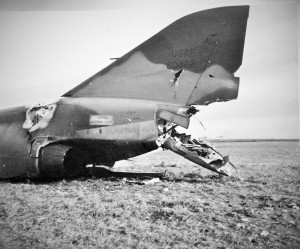
In this image you can see the damage to the tail section and one of the General Electric 16,900 thrust turbo engine.

Good view of wreck. Pilot and navigator were very fortunate, for as you can see there are many mountains about and as the fuel gauge showed only 20 pounds of fuel it could have been a tragedy.

In this photo you can see the USAF 80422 number on the vertical tail fin. Pilot did a fabulous job of crash landing it with 20 pounds of fuel and 400 ft. from impact, hell of a pilot and navigator
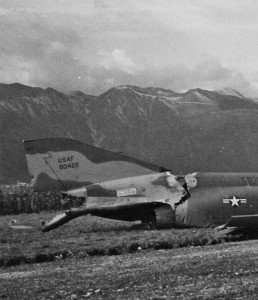
Close-up view of tail section wreckage on the grounds of Aviano Air Force Base, the Italian NATO Base. In the background you can see the rippling peaks of the Southern Carnic Alps in strategic Aviano, Italy

Italian fire truck from Aviano Air Base survey the area to make sure there is no possibility of fire restarting.

Phantom F4-E debris, if someone that reads this could email me if they are familiar with these parts.

Why there is an open space, as if something blew out of here in this Phantom F4-E top rear section of jet where the vertical tail fin begins. This is just above the twin turbojet engines

Here is the right side view of the hole where the exhaust for Phantom F4-E can be seen bottom right. There is a crack that runs to exhaust

Here is the left side view of the hole where the exhaust for Phantom F4-E can be seen bottom right. There is a crack is much wider on this side revealing more of the interior

Here is a close-up of the crack by the Phantom’s exhaust. Good view of interior construction and if you’ll notice along the bottom of photo there is a good view of the skin splitting away
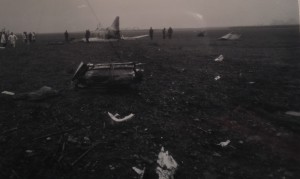
Phantom F4-E from the 32nd Tactical Fighter Squadron that flamed out and crashed one mile short of runway at the home of the 31st Fighter Wing in Aviano Air Base, Italy. Here we see part of the debris field left in the wrecks wake.

Close-up Phantom F4-E from the 32nd Tactical Fighter Squadron that flamed out and crashed one mile short of runway at the home of the 31st Fighter Wing in Aviano Air Base, Italy. Here we see a close-up of part of the debris field left in the wrecks wake.

Phantom F4-E from the 32nd Tactical Fighter Squadron that flamed out and crashed one mile short of runway at the home of the 31st Fighter Wing in Aviano Air Base, Italy. Here we see part of the debris field left in the wrecks wake. In the distance you can see the hangers for USAF 31st Fighter Wing

Close-up of Phantom F4-E from the 32nd Tactical Fighter Squadron that flamed out and crashed one mile short of runway covered with foam fire retardant. I am assuming that the two vertical poles have something to do with the ejection system that catapulted the pilot and navigator to safety
32nd Tactical Fighter Squadron

Phantom F4-E from the 32nd Tactical Fighter Squadron that flamed out and crashed one mile short of runway. Fireman making sure nothing is left to chance

Panorama view of Phantom F4-E from the 32nd Tactical Fighter Squadron that flamed out and crashed one mile short of runway at the home of the 31st Fighter Wing in Aviano Air Base, Italy. Here we see part of the debris field left in the wrecks wake. If you notice in background the hangers for the 31st Fighter Wing

Emergency vehicle inspecting aftermath of the Phantom F4-E from the 32nd Tactical Fighter Squadron that flamed out with 20 pounds of fuel left, amazing piloting. America, America, how proud of our military are we, till a man that was given everything could hate you so blatantly!

Front view of Phantom F4-E that flamed out and crashed one mile short of runway at Aviano Air Base, Italy on November 14, 1969

Close-up of firemen and equipment that serviced the Phantom F4-E that flamed out with 20 pound of fuel left and crashed one mile short of runway at Aviano Air Base, Italy on November 14, 1969

Fireman and equipment at the rear of the Phantom F4-E that flamed out with 20 pounds of fuel left and crashed one mile short of runway at Aviano Air Base, Italy on November 14, 1969

Close-up view of Phantom F4-E from the 32nd Tactical Fighter Squadron that flamed out with 20 pounds of fuel left and crashed one mile short of runway at the home of the 31st Fighter Wing in Aviano Air Base, Italy. Here we see part of the debris field left in the wrecks wake.

Rear of the Phantom F4-E from the 32nd Tactical Fighter Squadron that flamed out with 20 pounds of fuel left. It crashed at Aviano Air Base, Italy the home of the 31st Fighter Wing. In this photo you can see the two General Electric turbojets, each of which produced 17,900 pounds of thrust. They gave the Phantom a top speed of 1600 mph. At that speed the Phantom could fly from London to Istanbul in and hour and could reach an altitude of more than 50,000 feet.


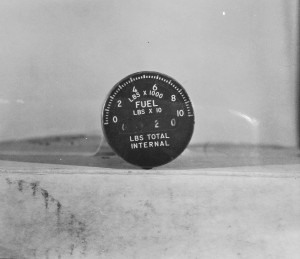


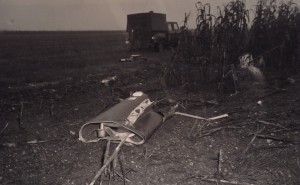

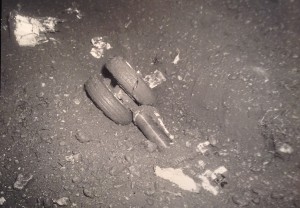




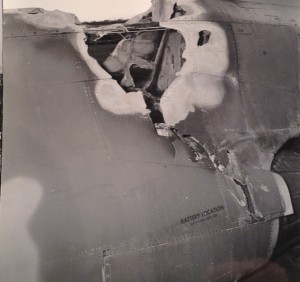
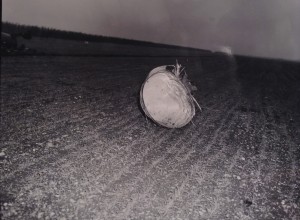

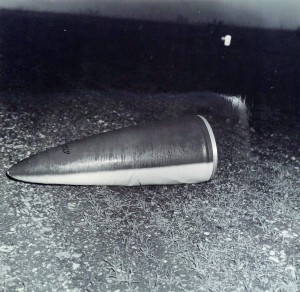





I ride with a guy Bob Nolli, that was his Dad Lt. Col. John Nolli
LikeLike
Captain John Thomas was an Instructor Pilot with Lt. Col. Nolli.
LikeLike
Thank you for your comment. It seems to me the control tower was at fault in that whole ordeal. I might have photos of your father in some of the 10 notebooks Col Davis kept. They are a snapshot of the era of the cold war that men like your father successfully executed to it’s conclusion. It is sad to see these youth of today screaming for socialism, a president that embraces the Castro’s his lifelong hero’s. That is the sadness of it all, the great sacrifice these great men & women and their families endured. I pray that our country will be salvaged before it becomes a third world country.
On Sun, Mar 27, 2016 at 10:45 PM, Estate Sale Treasure Hunter wrote:
>
LikeLike
My father was Lt. Col. John Nolli. He was the vice commander under Col. Davis at the time, and Maj Nebel was the head of operations. I remember it well. That accident got all of them sent back to the states within 6 months.
LikeLike
See comment below.
LikeLike
While TDY I removed the AN/ASN 48 and the AN/ASN 63 Inertial Navigation Systems cable harness from the aircraft that was near the runway about two weeks after the crash. The cable harness was used to make a hot mockup of all F4 Avionics at Bitburg AB, Germany home of the 36TFW.
LikeLike
Thank you for confirming the accuracy of the incident. The photo that brings home the urgency the pilots must have been feeling is to see that fuel gauge showing the 20 Pounds of fuel left. The skill of the pilot and navigator in setting down the phantom into a skidding motion leaving it almost intact is just amazing.
LikeLike
As the Approach Controller at Base Alpha (Aviano Air base, Italy) I confirm this this is an accurate depiction of the mishap.
LikeLike